Cellular Worlds – An Art Exhibition Inspired by Microscopic Universes
Posted by the Node, on 13 June 2025
From Saturday 31.05.2025 to Friday 27.6.2025, an art gallery in Heidelberg, Germany, presents an interdisciplinary exhibition combining art and science. The exhibition features the work of Dr. Ayelen Valko, a visual artist and cell biologist who explores the cellular universe to express its beauty and mystery to the general public. Through a blend of artistic techniques, metaphor and symbolism, Ayelen makes complex biological concepts accessible and engaging. The Node previously featured Ayelen in our SciArt profile. Here, we caught up with Ayelen again to find out more about her art, motivations and experiences as a scientist in the art world.

How did your interest in combining cell biology and visual art begin?
I have been painting and drawing my whole life. The natural world has always been my inspiration. My family often tells me that, as a child, I would spend hours drawing leaves and insects in my grandmother’s garden. However, it wasn’t until I began my Ph.D. program and was trained in various microscopy techniques that I realized how much artistic inspiration I could draw from microscopy images.
I have a dual background in art and science. I took several courses at the National University of Arts in Argentina, focusing on portrait and abstract painting and exploring traditional media, such as oil on canvas and acrylics. I then specialized in scientific and naturalistic illustration, developing skills in watercolor, scratchboard, graphite, and ink through courses and workshops at institutions such as the Ernst Haeckel Scientific Painting Lab, the Adumbratio Scientific Illustration Center, and Aves Argentinas.
Today, I use these and other techniques in mixed-media collages and paintings, which are mostly inspired by cell biology.

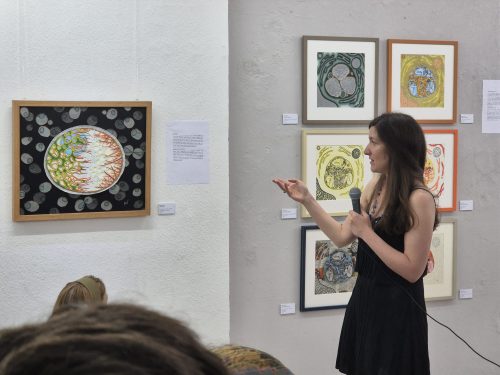
Why is the microscopic universe an interesting subject for an art exhibition?
To me, understanding the biological processes that sustain life can help us to appreciate it more fully. The microscopic world holds a quiet, yet powerful kind of beauty—both artistic and philosophical. Although it is not a common theme in the arts, the complex and fragile systems that keep cells alive offer endless inspiration. This makes the microscopic universe a fascinating subject for an exhibition: it invites viewers to look closer, to discover an unseen dimension of life that is usually reserved for scientists. Through my work, I aim to capture the essence of these biological processes and bring them to life on canvas in a way that makes them more accessible to everyone. I try to show the hidden beauty of cellular landscapes as I see them, filtered through my own experiences and imagination. My paintings and collages blend scientific ideas with artistic expression, shaped by memories, emotions, and the subconscious. In essence, my work brings together biology, art, and psychology.
… it invites viewers to look closer, to discover an unseen dimension of life that is usually reserved for scientists.
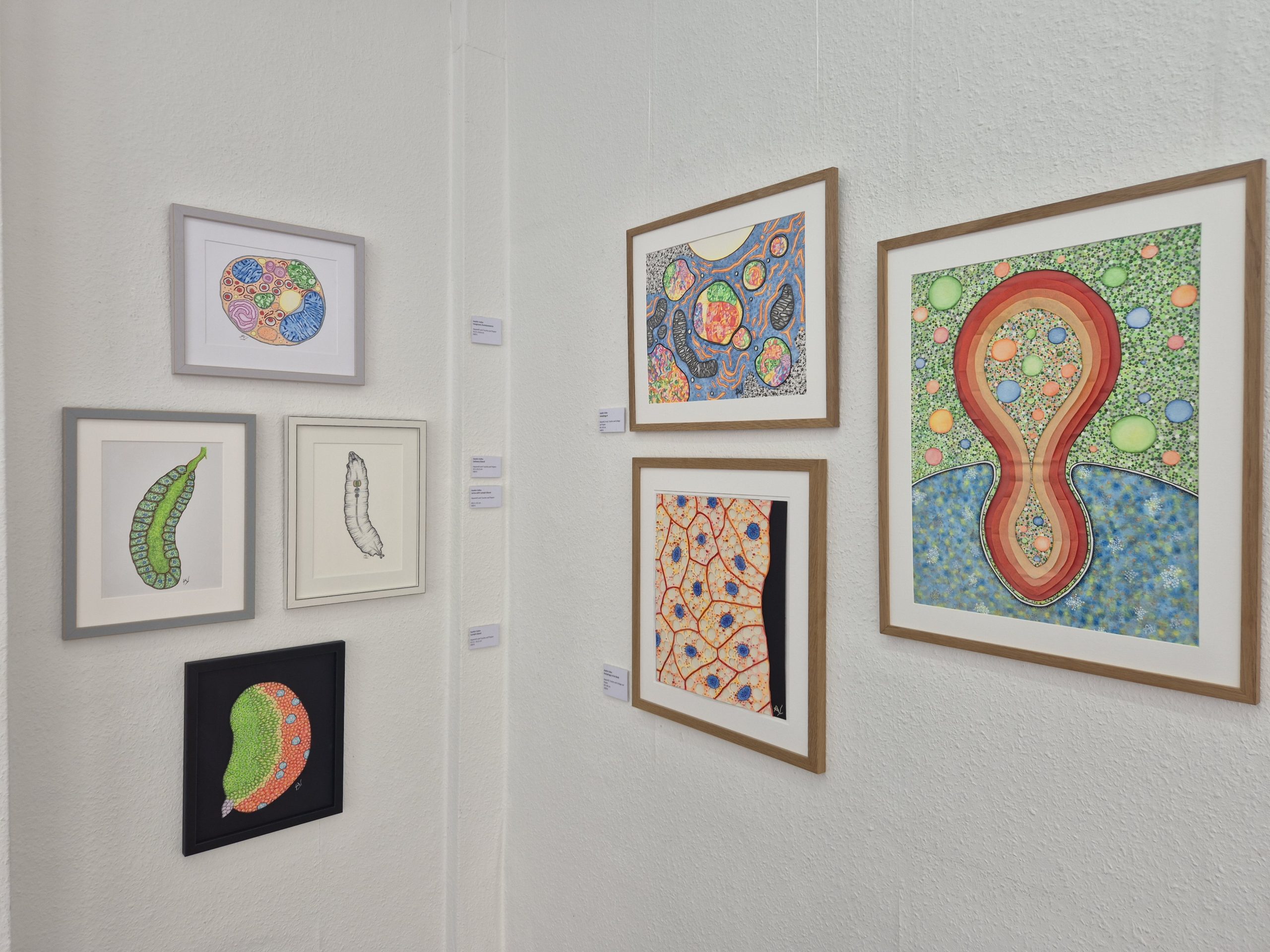
What is the idea behind the exhibition?
The concept behind this exhibition is to take the viewer on a visual journey that begins with whole organisms and gradually descends into the inner world of organs, tissues, individual cells, and intracellular compartments—revealing the wonders hidden within a single cell.
To achieve this, I used a wide range of materials and techniques, including inks, colored pencils, fineliners, watercolors, oils, acrylics, and markers, working on paper, canvas, and fabric. The exhibition also features collages made from diverse materials such as thread, fabric, newspaper, tissue paper, cardboard, plastic beads, and sand—or combinations of these.
One section of the exhibition is dedicated to scientific journal covers. There, viewers can see how some of my artworks have been adapted into journal cover illustrations, and read a selection of art-and-science articles I have written for some of those publications.
As the exhibition moves into the realm of subcellular landscapes, I present two ongoing series: Anthropo-Lysosomes and Origins in Blue. These explore opposing biological phenomena—destruction and creation, respectively—through metaphor and symbolism. In both series, I incorporate anthropomorphic elements into the cellular environments. I believe this helps make complex biological concepts more accessible than they might be in more purely abstract representations.
In Anthropo-Lysosomes, I focus on the cell’s digestive compartment—the lysosome. Across the series, three anthropomorphic figures appear inside the lysosome and undergo a progressive visual degradation, symbolizing biological breakdown and psychological vulnerability. I use a variety of techniques to emphasize different facets of destruction in each piece.
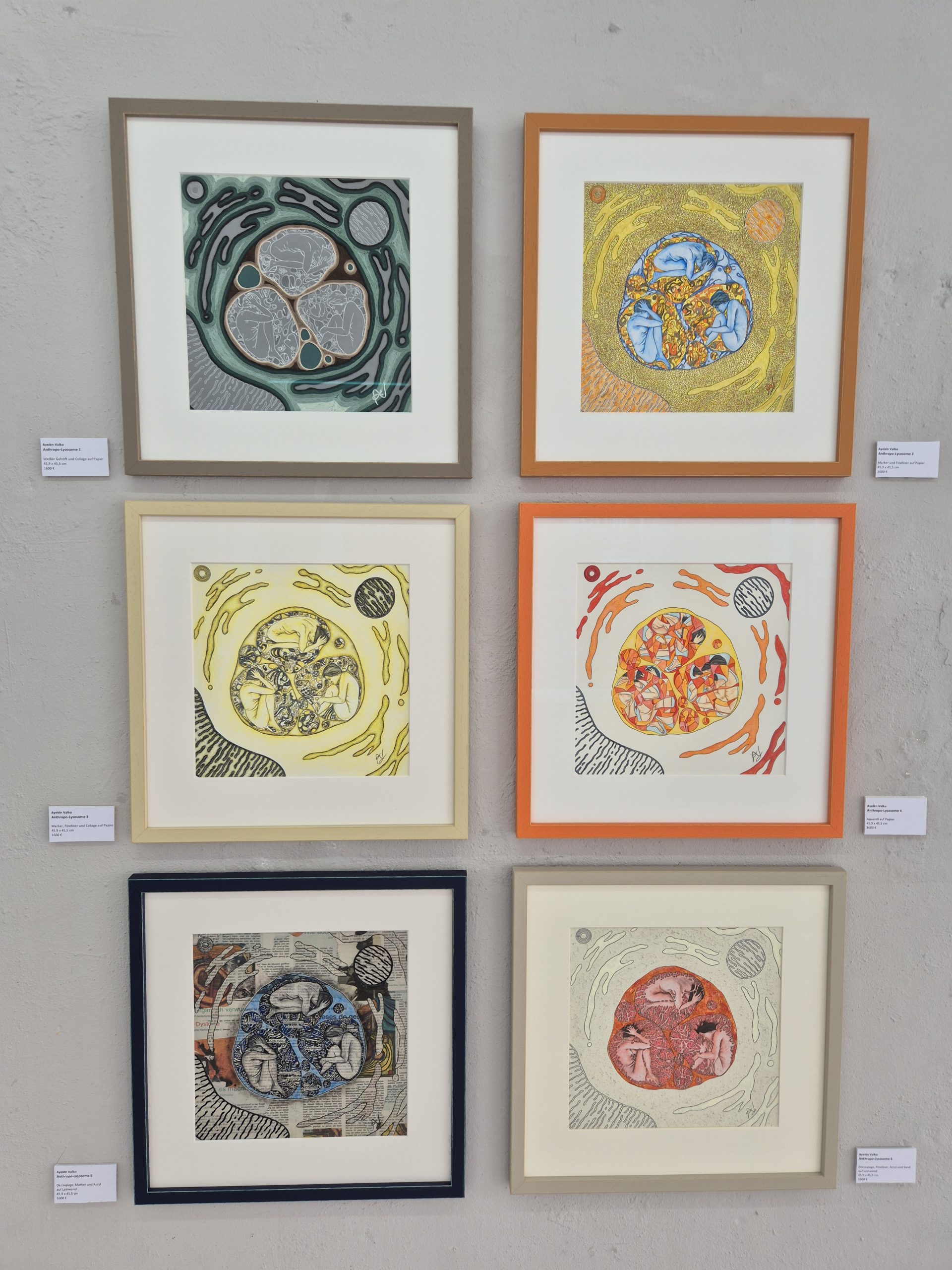
In contrast, Origins in Blue zooms into the mammalian ovary, starting from the organ level and moving toward a single oocyte. Along the way, the imagery becomes increasingly fantastical, blending imagined cellular structures with emotional and symbolic layers. This series explores not only anabolism—biological synthesis—but also interpersonal relationships, particularly themes of otherness, judgment, and inherited conflict. It touches on early childhood and the entry of a new individual into a world shaped by unresolved tensions.
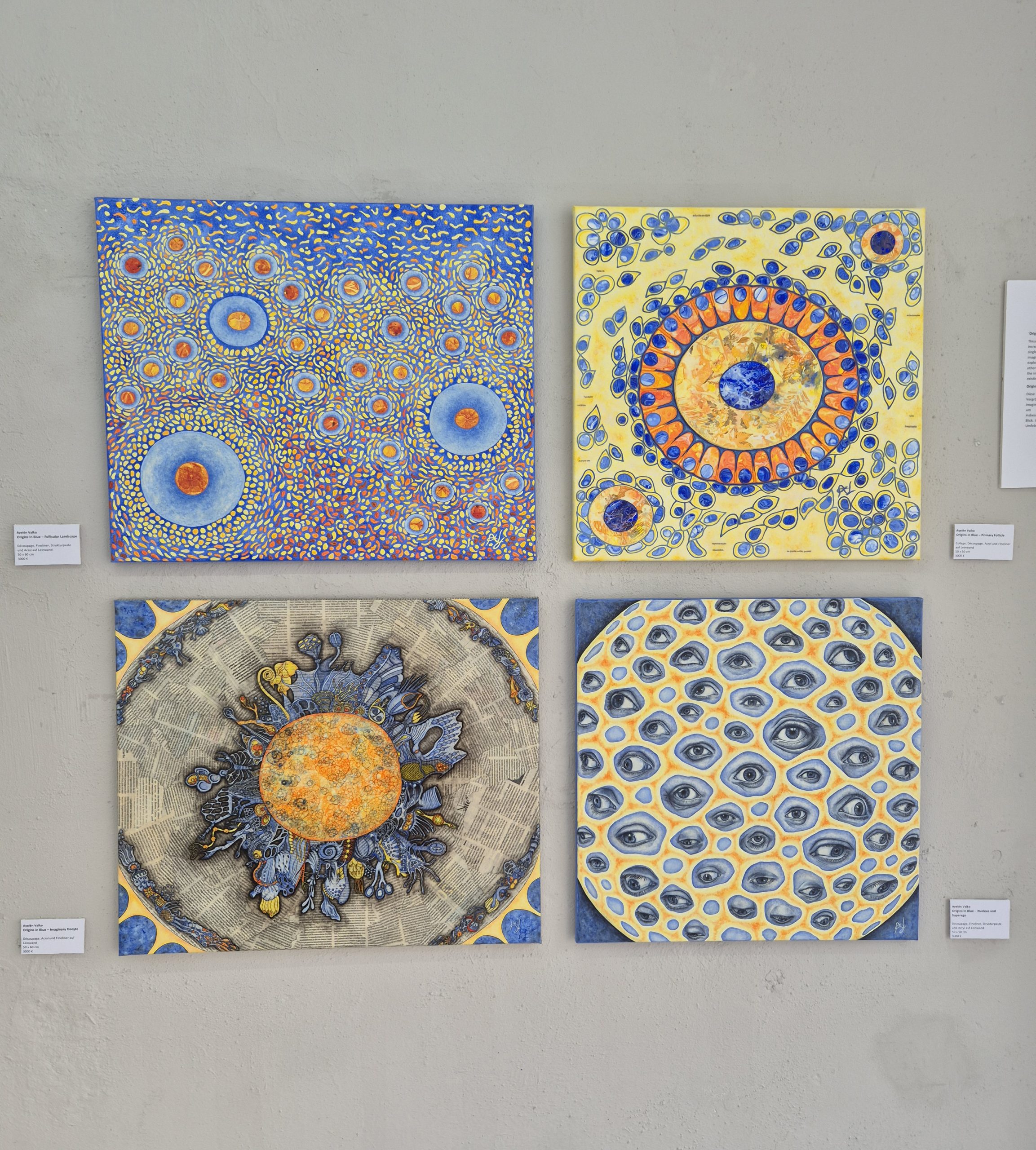
How does your background in biology shape your artistic expression, and why do you bring personal experience into that mix?
While it is common to see art used as a tool for science outreach, such as on journal covers or in graphical abstracts, it is much less common to see the relationship reversed, with science becoming a source of inspiration for artistic creation. This inverse perspective is precisely where my work is rooted. As both an artist and a biologist, I strive to depict the beauty and mystery of the cellular universe through my own subjective lens and lived experience. Consider the Surrealists, such as Remedios Varo and Frida Kahlo: They drew inspiration from psychology and the unconscious, but they weren’t trying to educate their audience about Freud or Jung. I asked myself, “Why not use the cellular and subcellular worlds as artistic inspiration without always aiming to explain or teach science?” I believe there’s real artistic value in that approach—finding inspiration in science for expression, not just communication.
As both an artist and a biologist, I strive to depict the beauty and mystery of the cellular universe through my own subjective lens and lived experience.
What challenges have you encountered moving between the scientific and artistic worlds?
Overall, it has been a very positive experience for me. Creating cover illustrations for scientific journals and participating in science communication activities, such as giving talks in schools and running art-and-science workshops, have been deeply rewarding. I find that these kinds of projects offer clearer pathways: you can submit a cover proposal or apply to speak at an outreach event. They’re more structured and predictable ways of combining art with science.
However, finding my place in the art world has been more challenging, especially when trying to exhibit science-inspired work in galleries and museums. This path—less clearly defined—has brought me a great deal of satisfaction, but also some real obstacles.
While most people are curious and supportive, there’s still some confusion about my work. The scientific community sometimes asks me why I “paint” science instead of conducting bench research. In the art world, science is often seen as too rigid, even contradictory to artistic freedom. There’s a lingering assumption that scientists might not be flexible or imaginative enough to truly belong in the arts. The tension of working between disciplines is very real. I often feel like I belong to both artistic and scientific worlds, but also to neither.
Another challenge I face is my preference for creating handmade works rather than digital ones. This can be limiting when approaching certain institutions that focus on “sciart” but lean heavily toward digital aesthetics. They often seek pieces resembling glowing, rotating DNA holograms seen in science fiction films, not for their meaning, but for their visual effect. In those spaces, form tends to outweigh substance, and my more intimate, tactile approach doesn’t always align with the curatorial vision.
Additionally, most art residencies and exhibition programs at scientific or artistic institutions that intertwine art and science are designed for artists or scientists who want to collaborate with the other discipline, but rarely for individuals who belong to both fields.
The tension of working between disciplines is very real. I often feel like I belong to both artistic and scientific worlds, but also to neither.
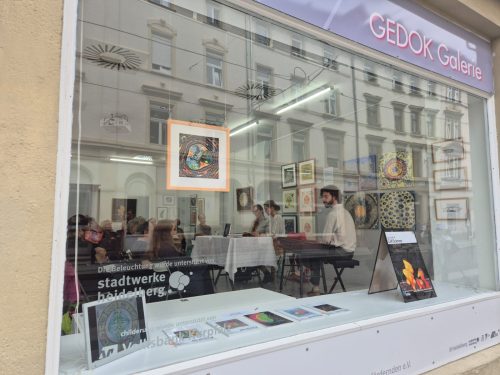
How did you find this art gallery and why you thought it was a good venue for your work?
I first came across the GEDOK Heidelberg gallery while walking through the city. I saw the exhibition they were showing at the time and thought it could be a good fit for my own work. So I waited for the next open call for new members, applied, and was accepted.
GEDOK is an artistic community in Germany — in fact, it’s the oldest and largest interdisciplinary network for female artists and art supporters in Europe. It brings together creators from the visual arts, music, literature, and beyond. Next year, the organization will celebrate its 100th anniversary, which speaks to its truly rich history. It has branches in 23 cities across the country, and I’m a member of GEDOK Heidelberg.
After becoming a member, I also applied for the opportunity to present a solo exhibition. A jury of artists and specialists accepted my proposal and gave me very encouraging feedback.
The exhibition was curated by Angelika Wild-Wagner and Anne Arend-Schulten, curators and artists from GEDOK, who accompanied me throughout the entire process. They helped me shape the exhibition concept and supported me during the installation. They also encouraged me to create a two-meter-long DNA sculpture that explores the theme of nature versus nurture, which is now part of the exhibition. It was a very enriching collaboration.
I also received support from Sabine Friebe-Minden, a graphic designer and fellow GEDOK artist. She developed the entire visual concept for the exhibition advertisement.
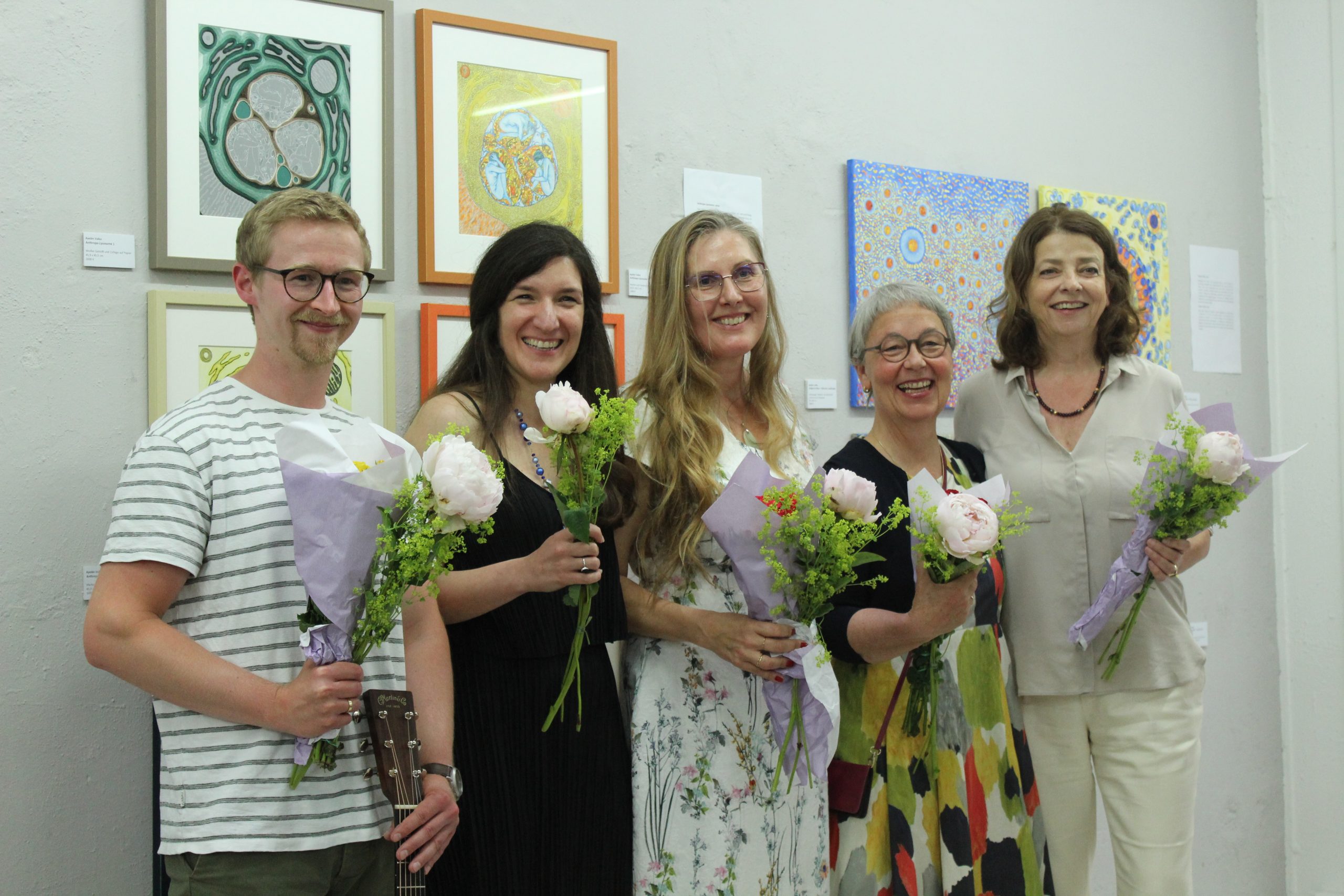

How has the public reacted to your work?
So far, the response has been very encouraging. The opening was well attended by a diverse audience.
Those with a scientific background often enjoy recognizing familiar cellular elements and biological processes. Some are drawn to scientific illustrations depicting different model organisms and organs, while others prefer more abstract cellular and molecular landscapes. Ultimately, it depends on each person’s interests and tastes.
Those without a scientific background tend to appreciate the works for their shapes, colors, and composition. Many engage with the idea of imagining the universe inside a cell, which opens the door to science communication and popularization.
Some visitors are also especially moved by the metaphors and symbolism. They connect with the psychological or emotional aspects of the work, demonstrating how the pieces can resonate on multiple levels.

What’s next for you?
I’m currently looking for new venues to exhibit my work—such as scientific institutions, museums, and art galleries—and I hope to collaborate more closely with both artists and scientists.
I also plan to finish the two series I mentioned earlier and to continue exploring new biological themes in my artwork.
In addition, I’d like to engage more deeply in science outreach activities. I particularly enjoy working with schools: I’ve given virtual talks to students in Argentina, my home country, and those experiences have been especially rewarding.
As part of this outreach effort, Lis Albert, a science communicator and PhD student at Heidelberg University, and I will lead a science communication activity for high school students at the gallery. On June 23, ninth-grade students from Helmholtz-Gymnasium Heidelberg will participate in the session with their teacher, Silke Reinhardt. We will use my science-inspired art as a starting point to talk about cell biology and laboratory work.
At some point, I’d also love to connect with publishers to develop a book on art and science. It’s an idea I’ve been thinking about for a while, and one I’m eager to explore further.
Find out more about Ayelen and her work:
https://ayelenvalko.com and Instagram @ayelenvalko


 (11 votes)
(11 votes)